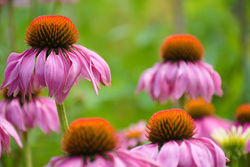Beginner's guide to dividing Herbaceous Perennials
- Lars Wildes
- Sep 29, 2024
- 5 min read
Dividing herbaceous perennials is one of the most rewarding tasks in gardening. Not only does it help rejuvenate tired plants, but it also provides you with free plants to expand your garden or share with friends. If you're new to this process, don't worry—this guide will walk you through everything you need to know, from the benefits of dividing perennials to the best time and methods for doing so. By the end, you'll be confident in dividing your own plants and helping your garden thrive for years to come.
What Are Herbaceous Perennials?
Before diving into the process of division, it’s essential to understand what herbaceous perennials are. Unlike annuals, which complete their lifecycle in one growing season, or biennials, which take two years, perennials return year after year. Herbaceous perennials specifically refer to plants that die back to the ground each winter and regrow in the spring.
Examples include Echinacea (coneflower), Hosta, and Rudbeckia (black-eyed Susan).
Why Divide Herbaceous Perennials?
Dividing perennials isn't just about creating more plants. Here are several key reasons why division is essential for garden maintenance:
Encourages Healthy Growth: As perennials grow, their roots can become crowded, leading to reduced flowering and overall vigor. Dividing them frees up space, allowing the roots to spread and the plant to thrive.
Prevents Disease: A crowded root system can harbor diseases and pests. By dividing your plants, you reduce competition for nutrients and lessen the risk of disease.
Increases Flower Production: If your perennials are flowering less each year, it's a sign that they might need dividing. A divided plant will have more energy to produce blooms.
Expands Your Garden for Free: One of the best perks of dividing is that you can expand your garden without buying new plants. Each division will grow into a fully-fledged plant, giving you more beauty for less money.
When Should You Divide Herbaceous Perennials?
Knowing when to divide your plants is crucial to ensuring they recover quickly and continue growing healthily. The best time to divide perennials depends on the type of plant, but a general rule is:
Spring-blooming perennials should be divided in fall (late summer to early fall) to give them time to recover and establish roots before the next growing season.
Summer- and fall-blooming perennials should be divided in spring when the soil is warming up, and they are just beginning to show signs of new growth.
Tip: Avoid dividing plants during the heat of summer, as the stress of both dividing and extreme temperatures can overwhelm them.
How to Know When Your Perennials Need Dividing
There are a few telltale signs that your plants are ready for division:
Reduced Flowering: If your plant is flowering less than it did in previous years, it might be time to divide it.
Crowded or Overgrown Clumps: Perennials that have grown into dense, overcrowded clumps will benefit from being divided. For example, if the center of the plant begins to die out, leaving a “doughnut” shape, this indicates overcrowding.
Plant Is Too Large for Its Space: If your perennials are taking over more of your garden than you’d like, dividing them will help you control their spread.
Tools You’ll Need for Dividing Perennials
Having the right tools on hand will make dividing your perennials much easier:
Spade or Garden Fork: Used for digging up the plant.
Sharp Knife or Garden Shears: For cutting through tough roots. A sharp tool ensures clean cuts, which reduce the chance of damaging the plant.
Bucket of Water: To keep roots moist while you work.
Compost or Fertilizer: To enrich the soil when replanting.
Mulch: For protecting your newly planted divisions and helping retain moisture.
How to Divide Herbaceous Perennials: Step-by-Step Process
1. Prepare the Plant for Division
Before dividing, water the plant thoroughly the day before. This reduces stress on the plant and makes it easier to work with.
2. Dig Up the Plant
Start by gently digging around the plant, being careful not to damage the root system. Use a spade or garden fork to loosen the soil around the root ball. Once loosened, lift the entire plant out of the ground.
3. Shake Off Excess Soil
Gently shake off the excess soil around the roots. This makes it easier to see the root system and decide where to make your divisions.
4. Separate the Plant
For smaller plants, you can often separate the clumps by hand. For larger, more established plants, you may need to use a sharp knife or garden shears to cut through the root ball. Aim to keep several shoots and healthy roots in each division. Ensure that each section has a good amount of healthy foliage and roots attached.
5. Trim Dead or Damaged Roots
Before replanting, trim away any dead or damaged parts of the root system. This will help encourage new growth and ensure the health of the plant.
6. Replant Immediately
Once you've made your divisions, replant them as soon as possible. Dig a hole twice the size of the root ball, place the division in the hole, and cover with soil. Firm the soil around the plant and water it well. **Space the plants** according to their mature size to avoid future crowding.
7. Aftercare
Water your newly divided perennials regularly, especially during the first few weeks as they establish their roots. Applying mulch around the base of the plants helps retain moisture and protect them as they settle into their new home.
Perennials That Benefit from Division
While most herbaceous perennials can be divided, here are some of the most common ones:
Hostas: Divide every 3–4 years to keep them healthy and prevent overcrowding.
Daylilies (Hemerocallis): Benefit from division every 3–5 years to encourage more blooms.
Coneflowers (Echinacea): Divide every 3–4 years for better flowering and plant health.
Black-eyed Susans (Rudbeckia): Can be divided every 3–5 years to prevent overcrowding.
Yarrow (Achillea): Divide every 2–3 years for healthier plants and vibrant blooms.
Bee Balm (Monarda): Divide every 2–3 years to prevent mildew and keep the plant vigorous.
What About Woody Perennials?
While the division process works well for herbaceous perennials, woody perennials like lavender or rosemary don't respond well to division. These plants have a more rigid structure and do better with propagation through cuttings rather than division.
For lavender, taking semi-hardwood cuttings in late summer is a better way to propagate the plant without harming its structure.
Common Mistakes to Avoid
Dividing Too Often: Over-dividing can stress the plant and lead to poor growth. Most perennials only need dividing every 3–5 years.
Ignoring Watering Needs: Newly divided plants need extra water, especially during the first few weeks. Neglecting this can lead to transplant shock and even death.
Dividing in Extreme Heat or Cold: Stick to the ideal times of early spring or fall for dividing. Dividing plants in the heat of summer or the cold of winter can cause unnecessary stress.
Not Giving Plants Enough Space: Crowding your divisions will only lead to more problems down the road. Give each plant enough room to grow to its full size.
Dividing herbaceous perennials is a simple and effective way to keep your garden healthy, vibrant, and full of blooms. Whether you're dividing to encourage new growth, increase flowering, or create more plants, following these steps will set you up for success. By understanding when and how to divide your perennials, you'll ensure that your garden thrives for many years to come.
So grab your spade, sharpen those shears, and start dividing—you'll be rewarded with a lush, flourishing garden and plenty of new plants to enjoy!






Comments